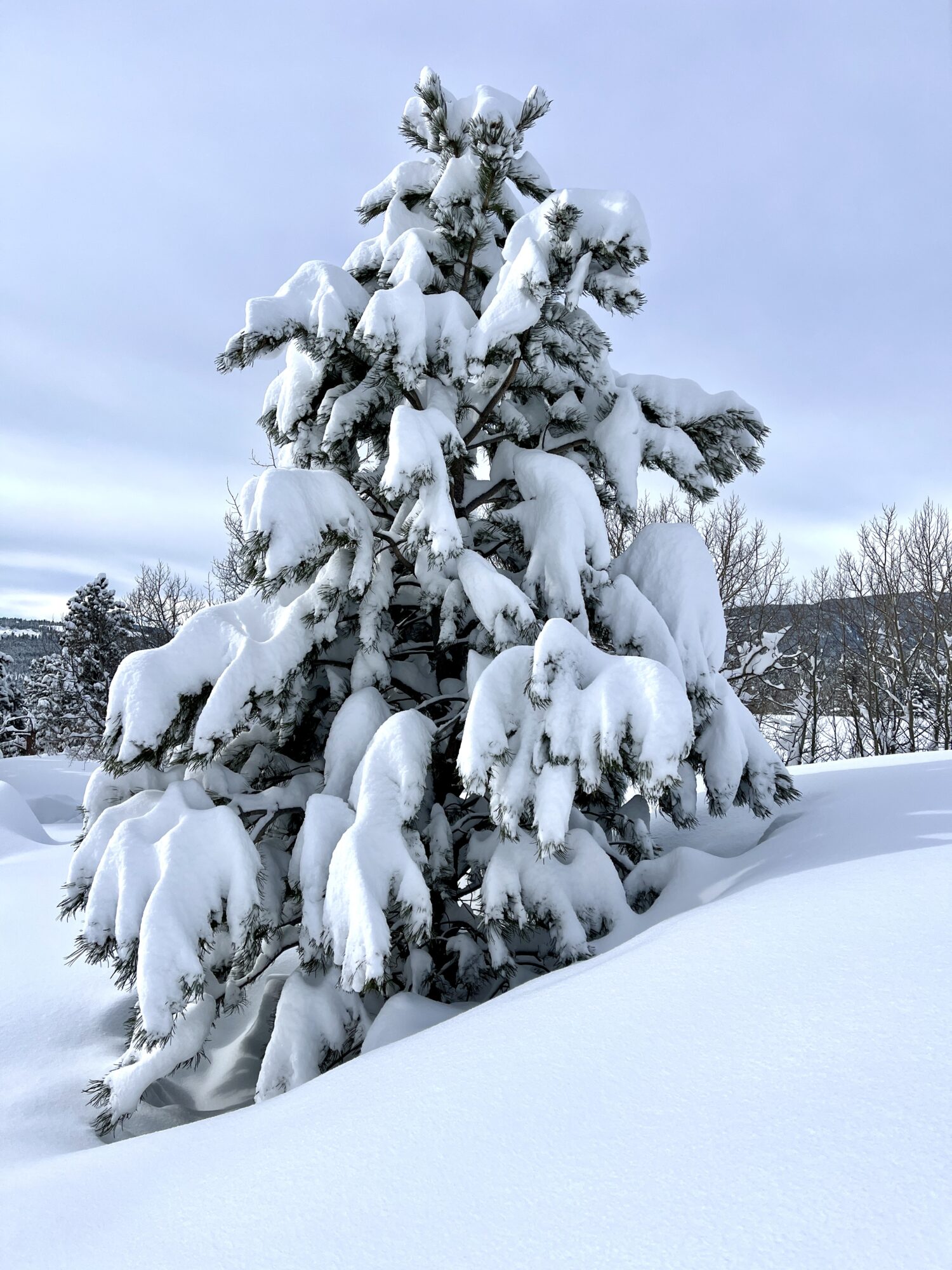A winter storm came through Colorado last week. Four feet of snow fell in 48 hours in the little town of Nederland, just thirty miles from where I live. Many rushed away from the mountains, trying to get to low ground before they closed roads and lost power. We rushed toward the storm. Kurt and I thought that if we went to the mountains, we could be some of the first people at Eldora Ski Resort, carving fresh tracks in historic levels of powder.
What happened instead was that we got snowed in. We slept at our friends’ home, but when we woke up to 36” of snow, we were unable to get to the ski resort. We couldn’t even get out of the driveway. The snow overwhelmed the plow trucks, landing one of them in the ditch. They closed the ski resort and most roads remained impassable. So instead of an epic day of skiing, we spent two days helping our friends shovel their driveway, decks, and roof.
When the snow kept falling, fast and deep, we slowed down and absorbed the silence. I caught myself staring out the window for a long time, in awe of the natural design of a pine tree, how its branches bend without breaking. Then I thought about the bears hibernating in this same silence, how their heartbeats slow from about 50 beats per minute to 12 beats per minute all winter. I curled up under a blanket and imagined slowing down to bear speed.
Last month, because I wrote a blog about Willie Nelson, a friend told me about a podcast called “One by Willie” in which famous people talk about a single Willie song that impacted them. In one episode, Brené Brown, sociologist and storyteller, spoke about Willie’s version of “Amazing Grace.” The way he sang it made her realize that she had misheard the song her whole life. She thought the lyrics were, “It was grace that taught me how to feel.” But when Willie sang, she heard the true lyrics which are, “It was grace that taught me how to fear.” How could that be?
After that podcast, I listened to “Amazing Grace” on repeat. I, too, misunderstood the song for years. And now it deeply resonated. I don’t need to be afraid of fear or its cousin, anxiety.
I’ve been through enough sh** that I know how to fear.
I can drive toward the storm because I’ve been through storms before, and I know they are not permanent. It’s tough to remember that when I wake in the night in a cold sweat, anxious about my scan results, my family’s health, money woes, or bloodshed and violence in the world. But now Willie and the famous hymn remind me that “Grace taught me how to fear, and grace my fears relieved.”
But what exactly is grace? Kindness, forgiveness, trust, undeserved, unconditional love? All of it, I’m guessing. It is also moving with elegance and fluidity, something fear prevents us from doing. So we have to learn how to fear better.
The goal is not to banish fear, but to learn how to be afraid, and move through it.
And we do that by accepting the fear, not denying it, and paying attention to what we can trust. Can we trust that eventually our load will be lifted, the sun will come out again, and life will continue?
Emily and Amelia Nagoski, two brilliant sisters, wrote Burnout pre-pandemic about unlocking the stress cycle. The brain research they describe is that when we push stress down or away, we never process it properly and we end up storing it in our bodies until we burnout. I believe that something similar happens with fear.
We have a new goal: to learn how to complete the fear cycle.
When fear rises, don’t try to make it go away. Instead, ride the emotion, move your body, cry, scream, breathe, and feel all the feels. Then get up and do something creative. Creativity is a powerful antidote to spinning out because of fear. And for reasons I don’t quite understand, it is the final step in completing the fear cycle.
My go-to creative act is writing, for Kurt it is playing guitar, for Hazel it is singing, dancing, or watercoloring, for Cole it is repairing an old car engine. What is it for you? How can you learn how to fear better?
Whatever your routine is to complete the fear cycle, do it. Don’t let it get stuck in your body. Write down those go-to things that help you to complete the fear cycle on a sticky note and put it on the bathroom mirror. Then remember that fear is something we learn how to manage, not something we run and hide from. We can learn how to fear better with practice.
For the skiers out there who are curious, the sun came out and they opened the ski mountain. But by then, Kurt had caught a ride home. I stayed because the peace of the storm was good for my nervous system. And because our friends were kind enough to let me stay. So when they opened the resort, I was one of the first people on the hill. Only the temperatures had warmed; It was not the light, fluffy powder I expected, but more like heavy cement.
I looked down from the chairlift to see five people on one of the steepest slopes. No one was moving. They were at a complete standstill, unable to make it through the deep snow. When it was my turn, I hugged the shady edge, pointed my skis downhill, leaned way back, and let them run. “I know how to fear!” I screamed as I sped past the stuck skiers. I laughed at my own ridiculousness and eventually fell into four feet of forgiving snow. Then I hopped on the chair to go back up and do it again.
It reminded me of what I learned by staring at those pine trees. They bend but don’t break, and when the sun comes out, they let go of everything they are carrying. That’s a pretty good way to make it through a storm.
Love,
Susie

